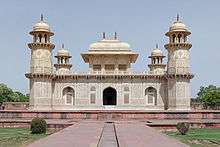Mirza Ghiyas Beg
Mirza Ghiyas Beg (Persian: مرزا غياث بيگ) was an important Persian official in the Mughal empire, whose children served as wives, mothers, and generals of the Mughal emperors.
Biography
After the death of his Ghiyas' father, his family's fell into disgrace. Hoping to improve his family’s fortunes, Ghiyas Beg chose to relocate to India where the Emperor Akbar's court was said to be at the centre of the growing trade industry and cultural scene.[1]
Half way along their route the family was attacked by robbers who took from them the remaining meager possessions they had.[2] Left with only two mules, Ghiyas Beg, his pregnant wife, and their three children (Muhammad Sharif, Asaf Khan and a daughter Sahlia) were forced to take turns riding on the backs of the animals for the remained of their journey. When the family arrived in Kandahar, Asmat Begum gave birth to their second daughter. The family was so impoverished they feared they would be unable to take care of the newborn baby. Fortunately, the family was taken in by a caravan led by the merchant noble Malik Masud, who would later assist Ghiyas Beg in finding a job in the service of Emperor Akbar. Believing that the child had signaled a change in the family’s fate, she was named Mehrunnisa or ‘Sun among Women’.[3] Ghiyas was later appointed diwan (treasurer) for the province of Kabul. Due to his astute skills at conducting business he quickly rose through the ranks of the high administrative officials. For his excellent work he was awarded the title of ‘‘Itimad-ud-Daula‘‘ (‘Pillar of the State’) by the emperor.[2]
As a result of his work and promotions, Ghiyas Beg was able to ensure that Mehirunnisa (the future Nur Jahan) would have the best possible education. She became well versed in Arabic and Persian. She also became well versed in art, literature, music and dance.[4]
Ghiyas' daughter, Mehrunissa (Nur Jahan) married Akbar's son Jahangir in 1611, and his son Abdul Hasan Asaf Khan served as a general to Jahangir.
Ghiyas was also the grandfather of Mumtaz Mahal (originally named Arjumand Bano, daughter of Abdul Hasan Asaf Khan), the wife of the emperor Shah Jahan, responsible for the building of the Taj Mahal. Jahangir was succeeded by his son Shah Jahan, and Abdul Hasan served as one of Shah Jahan's closest advisors. Shah Jahan married Abdul Hasan's daughter Arjumand Banu Begum, Mumtāz Mahal, who was the mother of his four sons, including his successor Aurangzeb. Shah Jahan built the Taj Mahal to serve as Mumtaz Mahal's tomb.
Death
Ghiyas Beg died in January 1622. Nur Jahan commissioned the construction of I'timād-ud-Daulah's Tomb in Agra, which is as an architectural predecessor of the Taj Mahal.
References
Sources
- Shokoohy, Mehrdad (2001). "GĪĀṮ BEG, ʿEʿTEMĀD-AL-DAWLA". Encyclopaedia Iranica, Vol. X, Fasc. 6. pp. 594–595.
- Nath, Renuka (1990). Notable Mughal and Hindu women in the 16th and 17th centuries A.D. New Delhi: Inter-India Publ. ISBN 9788121002417.
- Gold, Claudia (2008). Queen, Empress, Concubine: Fifty Women Rulers from Cleopatra to Catherine the Great. London: Quercus. ISBN 978-1-84724-542-7.
- Keay, John (2000). India: A History. Grove Press, New York.

